Boerum Hill slow zone is vetted; Heights sure to watch closely

Concerned by the number of vehicular accidents within its borders, some involving pedestrians and some even resulting in fatalities, the transportation committee of the Boerum Hill Association set about researching successful slow zone programs abroad about four years ago. What committee members found was encouraging; newly implemented slow zones in London resulted in a 46 percent reduction in fatal and severe injury crashes compared to untreated areas. Impressive results had also been documented in Berlin, Zurich, Dublin, Stockholm, Helsinki and in the Netherlands.
Evidence in hand, the Boerum Hill Association approached NYC’s Department of Transportation (DOT) to advise them of their findings. But as it turned out, DOT had been researching slow zones on its own and had decided to pilot a number of programs where the speed limit would be reduced from 30 to 20 miles per hour in neighborhoods that applied for the program and met specific criteria. Boerum Hill hoped to be honored by having the first program in the city, but, ultimately, a neighborhood in the Bronx was chosen, and the Brooklyn community had to settle for the first pilot program in Brooklyn.
In order to obtain neighborhood feedback to assist DOT in tweaking the program, which was implemented this summer, Christopher Hrones, DOT’s Downtown Brooklyn Transportation Coordinator, attended the fall general membership meeting of the Boerum Hill Association on Oct. 24. In introducing Hrones, BHA President Howard Kolins stressed how cordial and accessible DOT has been in helping Boerum Hill fight a dangerous problem. He added, however, that in the opinion of some neighbors the slow zone program was “not as robust” as many hoped it would be.

Brooklyn Heights
View MoreRead the Brooklyn Height's Press and Cobble Hill News. Find out more about Brooklyn Height's History here.